Study: More Intense And Frequent Thunderstorms Linked To Global Climate Variability
Using isotopes from Texas cave stalactites, scientists in Texas A&M’s College Of Geosciences studied thunderstorm changes in the Southern Great Plains.
Jun 18, 2021

Dr. Chris Maupin, Audrey Housson ’16, and Lorraine McChesney ’16 half a mile underground in a Williamson County cave. (Photo by Chris Maupin)
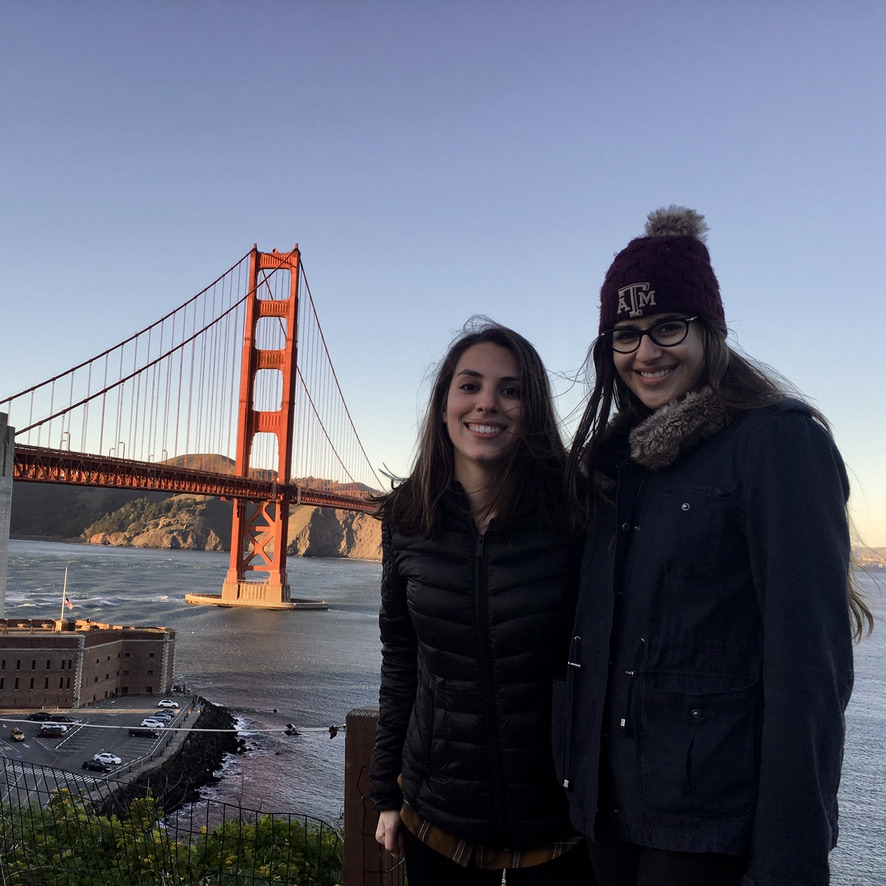
Large thunderstorms in the Southern Great Plains (SGP) of the U.S. are some of the strongest on Earth. In recent years, these storms have increased in frequency and intensity, and new research shows that these shifts are linked to climate variability.
Co-authored by Dr. Christopher Maupin, Dr. Courtney Schumacher, and Dr. Brendan Roark, all scientists in Texas A&M University’s College of Geosciences, along with other researchers, the research was recently published in Nature Geoscience.
In the study, researchers analyzed oxygen isotopes from 30,000–50,000 year old stalactites from Texas caves to understand trends in past thunderstorms and their durations, using radar-based calibration for the region’s rainfall isotopes. They discovered that when storm regimes shift from weakly to strongly organized on millennial timescales, they coincide with well-known, global abrupt climate shifts during the last glacial period, which occurred between about 120,000 and 11,500 years ago.
Through modern-day synoptic analysis, researchers learned that thunderstorms in the SGP are strongly related to changes in wind and moisture patterns occurring at a much larger scale. Understanding these changes and various correlations will not only help reconstruct past thunderstorm occurrences, but also help predict future mid-latitude thunderstorm patterns.
"This method of climate research is under-used and ripe for amplification," the researchers said.
“Proxy records are available in the Southern Great Plains within caves,” Maupin said. “There are probably thousands of caves in Southern Great Plains and in southern Texas. Why hasn’t more research occurred in those areas? Cave deposits are so promising as proxies.”
"Scientists understand modern-day rainfall patterns, and that really big storms can deplete isotopes," Schumacher said.
“However, we don’t know what will happen in the future, and this work will help predict trends of storms in the future. If we can run a climate model for the past which is consistent with cave records, and run that same model moving forward, we can trust its findings more if it matched the cave records versus if they didn’t,” she said. “Out of two models, if one really matches the cave isotopes then you can trust that one in understanding storm distribution in the future.”
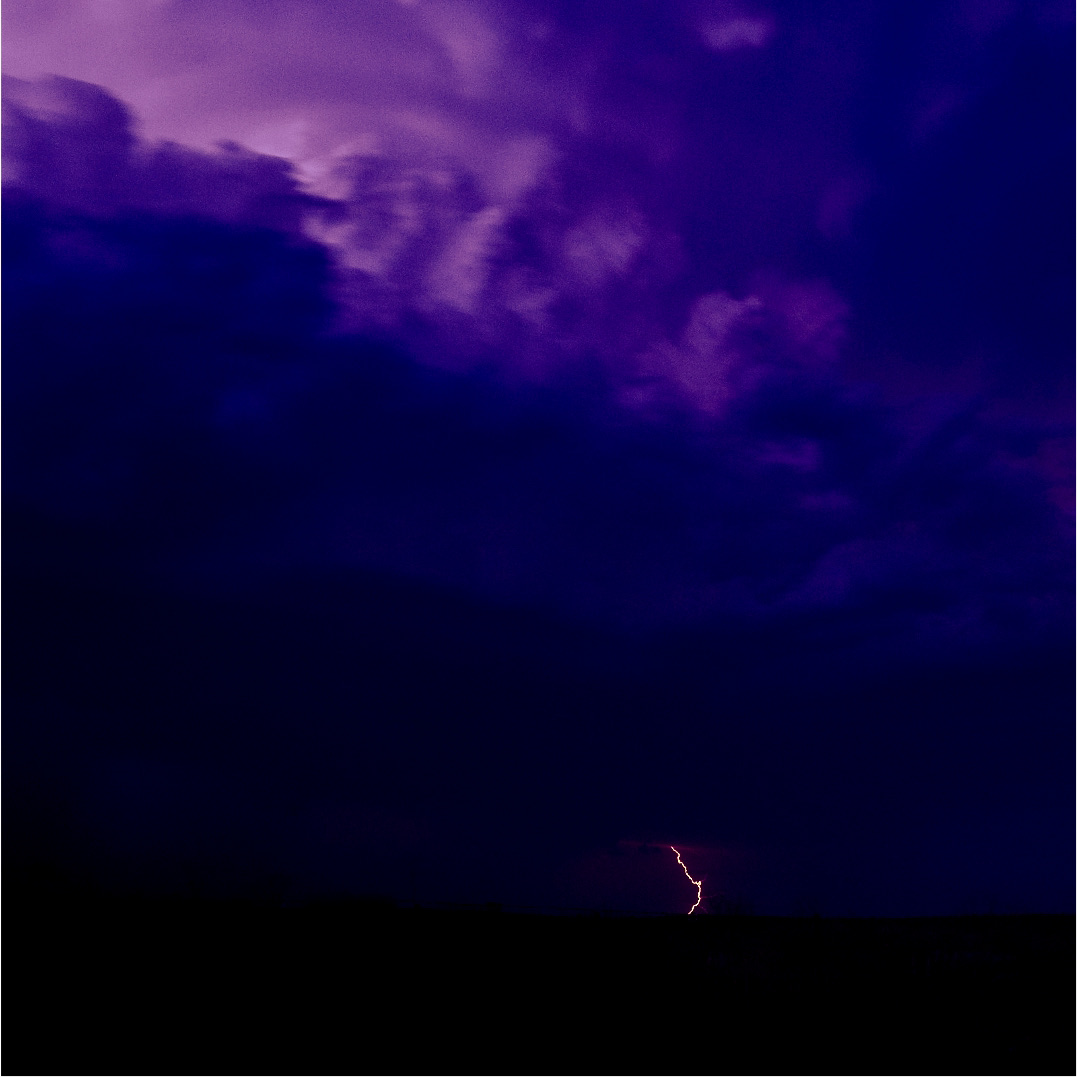
Southern Great Plains supercell thunderstorm. (Photo by Chris Maupin)
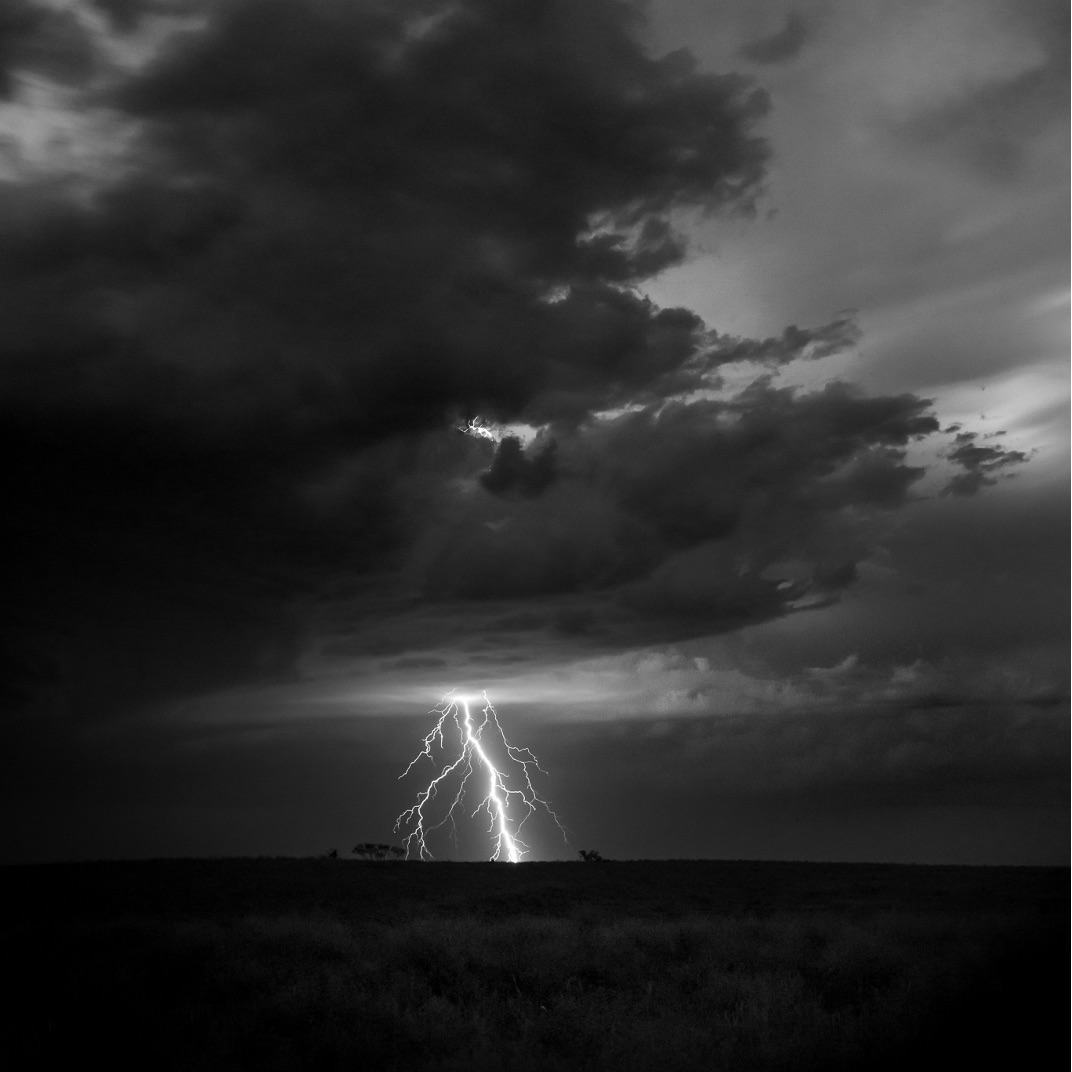
Southern Great Plains CG strike. (Photo by Chris Maupin)
Caves Hold Little-Known Climate Records
Maupin is a paleoclimatologist and described the limitations that exist in capturing the true distribution of weather events across time.
“There are really important questions about what has happened in the past regarding big weather events we get through mesoscale convective systems (large storms) vs. non-mesoscale (smaller storms) stuff,” Maupin said. “We get so much precipitation from really big storms, and model grids can’t capture big weather events, because the grids themselves are so big. Paleoclimatology helps with organizing past events to develop a proxy record of how they respond to mean climate.”
“What controls isotopes in rainfall? Texas doesn’t have changing moisture sources, altitude effects, etc. so it’s tough to identify what is being reconstructed,” Maupin said. “Every day it rained, we took water samples, measured the samples isotopic ratios, and then looked at radar data to understand how to pick out what is connected to a mesoscale convective system or regular rainfall event.”
Maupin collaborated with National Taiwan University to do uranium thorium dating, and discovered that the stalactites and stalagmites were in fact from around the Ice Age.
The team worked with environmental consultants SWCA and Cambrian Environmental that had already been working in Central Texas Karst voids, which are prevalent in the Austin and Williamson County region.
“Some caves have stalactites and stalagmites growing in them,” he said. “Sometimes new caves are breached by construction equipment, stalactites and stalagmites are broken off. We wanted to use those that were already broken, and from a conservation mindset approach, analyze the samples that were passed on to me.”
Research Experience For Undergraduate Aggies
Celia Lorraine McChesney ’16 and Audrey Housson ’16 were two undergraduate researchers involved in this publication, and both learned a great deal through the field work, collaboration, and high-impact learning experience.
“The samples from the caves were used as a tool for high-impact learning in understanding Texas paleoclimate,” Maupin said. “One of the undergraduates started micro-milling the stalactites. I was very fortunate to have access to the College of Geosciences’ resources and to work with these talented undergrads on ground-breaking research.”
Being the lab manager for the Stable Isotopes Geosciences Facility, Maupin enjoys working on research projects that students can get involved in whenever he has time. This publication allowed undergrads to engage in high impact research, and get familiar with many different instruments.
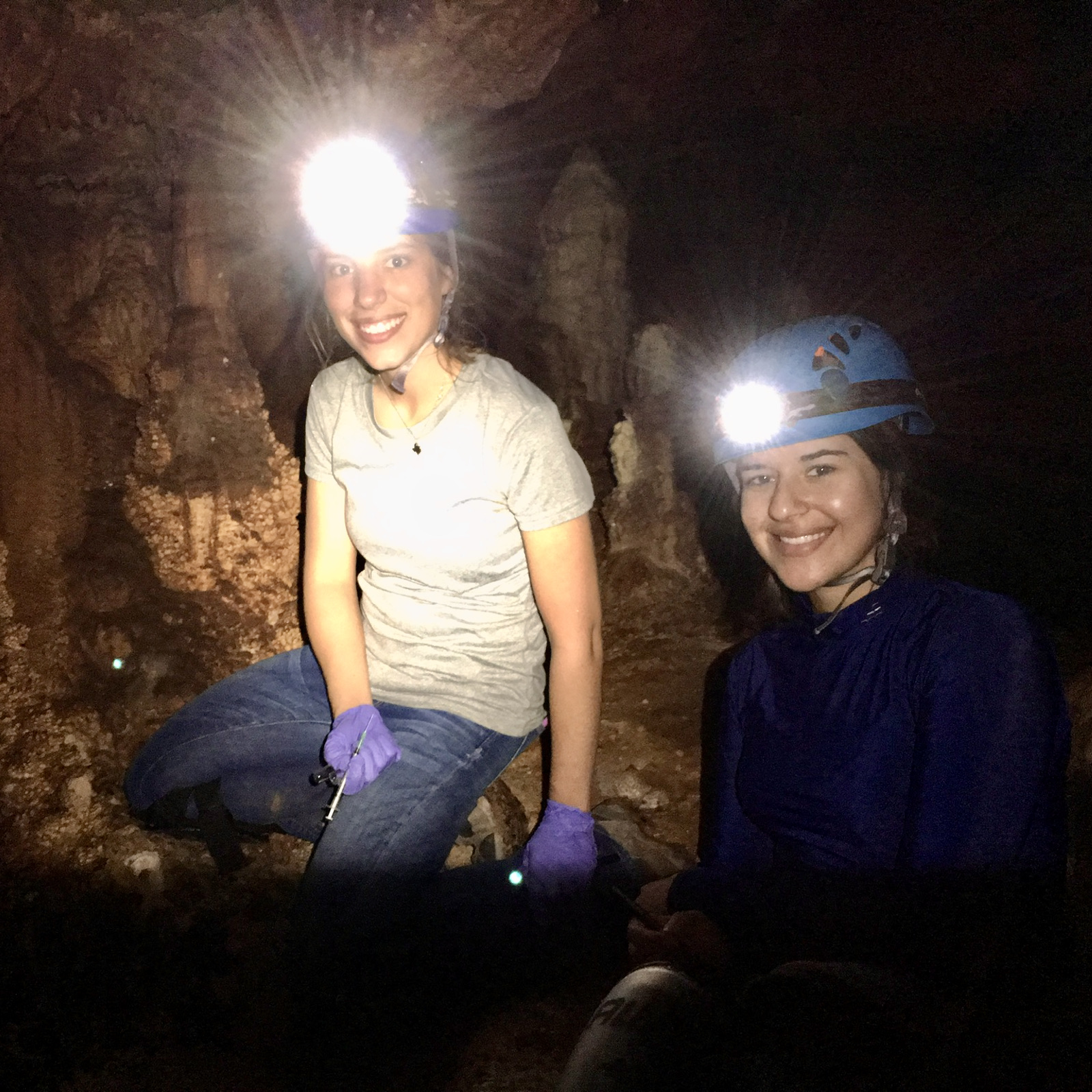
Audrey Housson ’16 and Lorraine McChesney ’16 collecting dripwaters and deploying temperature loggers in a Williamson County cave. (Photo by Chris Maupin)
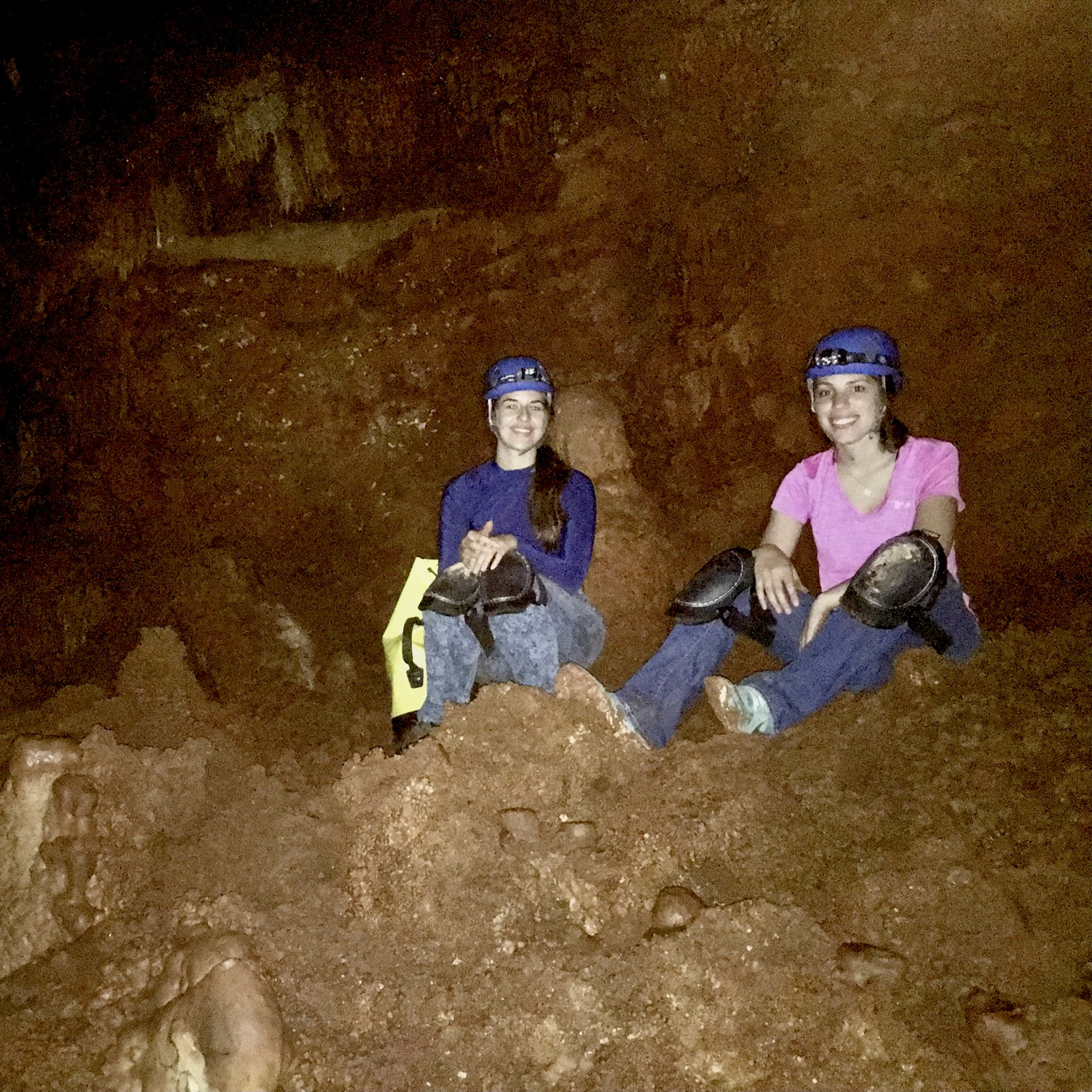
Audrey Housson ’16 and Lorraine McChesney ’16 collecting dripwaters and deploying temperature loggers in a Williamson County cave. (Photo by Chris Maupin)
“What happens if we have a whole bunch of mesoscale convective systems that rain for 2-3 days in a row? Lorraine worked on understanding more extreme distributions while Audrey built the record or rainfall events,” Maupin said. “As long as you have a supportive environment, anyone is capable of doing good research and coming up with good ideas.”
Both undergraduate researchers presented their research at the American Geophysical Union (AGU) annual conference in 2016.
“My experience working on my senior thesis at the SIGF lab was invaluable,” McChesney said. “This research has allowed me to travel and go out into the field.”
McChesney expressed the gratification researchers experience when conducting research outdoors.
“Emerging from the ground covered in mud after exploring a cave that few people have ever visited was definitely my favorite part of this process,” McChesney said. “Most importantly, the technical knowledge and work ethic that are involved in working on a project like this have stuck with me and are skills I carried into my professional life,” she added.
Having been one of the first to conduct their kind of research, undergraduate researcher Housson expressed her gratitude in having the opportunity to study various correlations to the paleoclimate record.
“As an undergraduate research student at Texas A&M, I was proud to be part of one of the first teams to correlate climate change and weather linkages in a paleoclimate record,” Housson said. “This whole experience provided great exposure to the academic world, and made me more confident as a scientist. Now, as a geologist and civil engineer, I am working on heavy civil infrastructure projects like tunnels and dams related to water resources. I love how my career ties back into my undergraduate research where knowing the correlation between climate change and weather helps plan for water resources in the future,” she added.
Interdisciplinary Collaboration
Schumacher’s expertise was needed to make connections with various rainfall events that occurred over time. She had experience working with radar data and rain measurements on a global scale.
“Large storms that cover hundreds of miles, provide around 50-80% of rain in Texas,” Schumacher said. “In the modern day, these storms have different isotope signatures.”
“Chris has modern day measurements, really unique information, which help reconstruct what has happened in the past,” Schumacher said. “He also has 30,000 – 50,000-year-old samples of stalactites and stalagmites.”
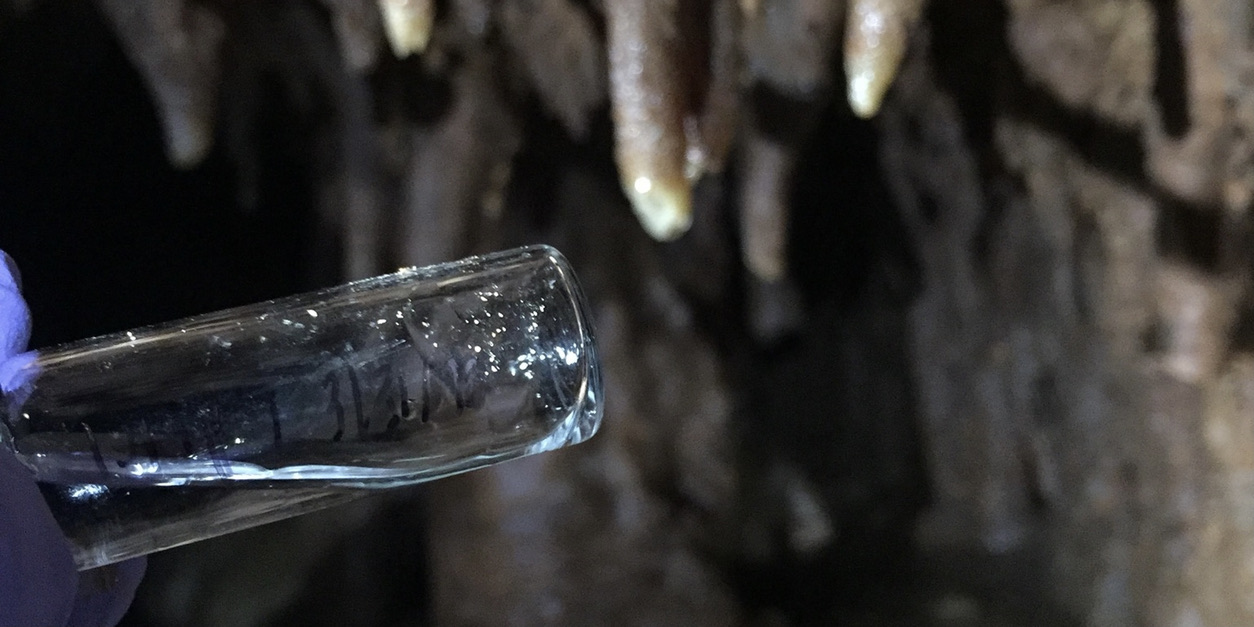
Lorraine McChesney ’16 holds a freshly collected dripwater sample retrieved for oxygen and hydrogen isotope ratio measurements. These measurements help link thunderstorm precipitation with speleothem-forming groundwater. (Photo by Chris Maupin)
Schumacher was interested to join this “paleo-radar” initiative because it allowed researchers to look at modern day records (in terms of storms and isotopes in Texas), and link them back to these ancient cave deposit observations.
“Making this link and showing very significant changes to storms over thousands of years is very powerful,” Schumacher said. “My role in this project was to help understand storm processes and how they may relate back to the isotope measurements in addition to large scale wind and moisture pattern dynamics in atmospheric circulations. I try to understand how storms may be impacted by changing weather patterns, and can tell you what kind of weather patterns these storms will form in, and when they might not.”
“Understanding basic principles of science make you realize the importance of taking daily rain measurements to understand what causes big storms,” Maupin said. “It’s raining, [these] are the physical processes involved. That’s what inspired taking daily measurements of rain.”
After samples of rain are taken, it is important to understand the isotope distribution within them to make connections between what kind of weather event they are from.
“People think you deplete heavier isotopes from different air when in fact it is big storms,” Schumacher said. “This finding is a huge paradigm shift, which made publishing these findings difficult.”
“These research discoveries are far from the standard model of studying paleoclimate and caves,” Maupin added.
Maupin’s research is pushing back on outdated principles in the paleo-world because you have to study how storms get larger and what influences them, he said.
“These thunderstorms are so big that even if most of the rain occurs in Oklahoma, rain in Texas will still carry isotopic signature of these huge storms,” Maupin stated. “You’re fingerprinting these systems despite where they occur, and they don’t have to be super localized to be recognized. Big storms cause depleted isotopic signatures. You can’t explain the variability in stalactites with temperature changes alone.”
“You can have the same amount of rain, and if you have a lot of little storms producing the same amount of rain as one big storm, you will get a very different isotopic signatures,” he said. “That really matters.”
Maupin clarified that this project’s analysis takes a simple ingredients-based approach of the knowledge researchers currently have, to understand the consistency in how the large-scale winds change to encourage or discourage these really big storms.
“Other people are very interested in this,” Schumacher said. “It has been a very interdisciplinary project, where we have had to bring in observational expertise from the weather and chemistry side, looking at model data etc.”
By Mariam Moeen '19, Texas A&M College of Geosciences

